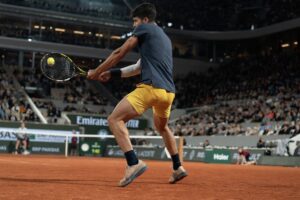There were some fantastic matches during the 2021 US Open. One of the stars of the tournament was Leylah Fernandez, who wowed crowds with her crafty game and competitive spirit. Every match Fernandez was involved in had drama, including the final.
The quarterfinal match against Ukraine’s Elina Svitolina caught my eye. However, not for reasons I imagined. Fernandez’s running crosscourt forehand in particular left me thinking, the shot reminds me of another player. Then it dawned, Leylah Fernandez’s crosscourt forehand reminded me of Pete Sampras’ crosscourt forehand!
Surprising as they are two different players from separate eras. But it became clearer, when forced out wide, Fernandez “hooks” her forehand crosscourt. Mainly by positioning her body with a semi closed stance and employing a flick of the wrist to get the spin and lift. A beautifully produced shot.
Monica Seles (another famous lefty) did something similar when she was stretched wide. Seles took her right hand off the racquet (double handed off both wings) and also hooked the ball with a flick of the wrist.
Why does the crosscourt forehand produced by Fernandez remind me of Sampras? Some things started to fall in place.
I recently watched on YouTube a re-run of the 1969 US Open final between Rod Laver and Tony Roche. I was struck by how similar Rod Laver’s game was to Sampras and wrote a comment under the video. The volleys in particular, especially the high to low volleys, getting the ball down low with slice. I knew Sampras grew up watching tapes of Laver when he was very young. Although, as they played in two completely different eras, I never paid much attention. Interestingly, during the 1990 US Open, the late Arthur Ashe commented that a 19-year-old Sampras reminded him of Rod Laver but “three inches taller”. Ashe played Laver many times.
Rod Laver v Tony Roche USO 1969 Final – YouTube
Consequently, Sampras’ shots were unique for a right handed player. This will explain why his game was so different, even if it was a conventional game. And no doubt contributed a lot to his overall success.
Starting with the serve. Sampras got more swing on his serve than any other right hander who played tennis at an elite level. Sampras adopted a more side on motion, not too dissimilar to John McEnroe (left hander). This allowed Sampras to stand closer to the centre line and swing the ball with slice and topspin on both deuce and ad courts. Good knee bend and flexible shoulder contributed to this as the ball swung away from the returner’s grasp. On the ad court, the ball often straightened up on the line itself, heading straight for the centre line judge. That’s why Sampras was called the “King of Swing”
Pete Sampras a collection of 2nd serve Aces Pt 1 – YouTube
Such swing on the serve is usually the domain of left handers, like Goran Ivanisevic. This precision led to the famous guessing game for returners, where would Sampras serve the ball. Sampras used an identical ball toss to hit all six targets of the service box, in the corners and into the body
A study from the 1998 US Open here showed that Sampras generated more spin on his serve than his opponents, sometimes over 4000 rpms on serves upwards of 193 kph (120mph). This is an astonishing amount of spin at pace as Sampras often served between 200 and 220kph. Andy Roddick sums it up nicely, calling it the “Sampras Tail” Roddick said “before it gets to you, it tails away and grinds against your racquet strings, it makes it a lot tougher.” Similar to a fast bowler in cricket who moves the ball off the seam to deceive the batsman. The ball moves away after pitching to entice the batsmen to edge the ball for a catch.
Another unique factor of Sampras’ game as a right hander is his forehand, one of the most famous in history. The running forehand was a devastating shot, down the line and crosscourt. Sampras’ forehand was considered one of the best groundstrokes throughout the 1990s, taking over from Ivan Lendl and Jim Courier.
Sampras’ stroke production is extremely interesting. using an eastern grip, like Ivan Lendl and more recently Roger Federer. However, Sampras manipulated his racquet in a vastly different way to the other players mentioned. When Sampras hit the forehand down the line, he often took the ball on the rise, or half volley and with sidespin. Right handers will use sidespin from time to time but will usually come over the ball with topspin when stretched. Sampras would use sidespin almost exclusively.
This is significant for two reasons. The first, Laver as a left handed player using a small wood racquet, would use sidespin to hit shots on the run, especially as surfaces were lower bouncing back then (grass and indoor wood). The second, former pro and left hander Jeff Tarango often claims he taught Sampras the shot when they were juniors together in California.
Sampras hit the running forehand down the line with speed, and superb control. Dipping the ball over the high part of the net, the spin taking it beyond the opponent well into the court. No other right hander hit the running forehand down the line in that fashion. There is a vast array of compilations of the Sampras running forehand down the line shots on YouTube. On one video a comment was made that Sampras and Nadal’s running forehand down the line “mirror each other”. Rafael Nadal is also unique. He learned to play tennis left handed even though he is right handed.
The Sampras crosscourt forehand is another famous shot. The way Leylah Fernandez hooks the ball when stretched out wide is something not too many right handed players do naturally. Sampras got amazing angles on his crosscourt shots with height and depth by flicking the wrist, whether his opponent was at the net or not. It is very rare for right handers to get those angles, again making his game unique.
These are things Sampras adopted and adapted from Laver’s game, consciously or subconsciously. Other aspects are more modern, such as the inside out and inside in forehand which was more of a nod to Ivan Lendl from the 1980s. By the 1980s there were a lot more higher bouncing hardcourts than in the 1960s and 70s. However, like Laver, Sampras used his speed and athleticism around the court to turn defence into attack. Laver’s sharp passing shots off both forehand and backhand were impressive, something Sampras certainly excelled at. Sampras also moved effortlessly with clean ball striking, like many lefties.
It has been a conundrum trying to figure out what made the Sampras tennis game unique. Considering, he was one of many players who played an all-court game. I think the code has been cracked; Sampras played a game more akin to a left hander for a right hander. Sampras troubled opponents in a way other right handed players couldn’t. The deception Sampras acquired from studying left handed players allowed him to cultivate a game to stay ahead of the pack.
Main Photo:






